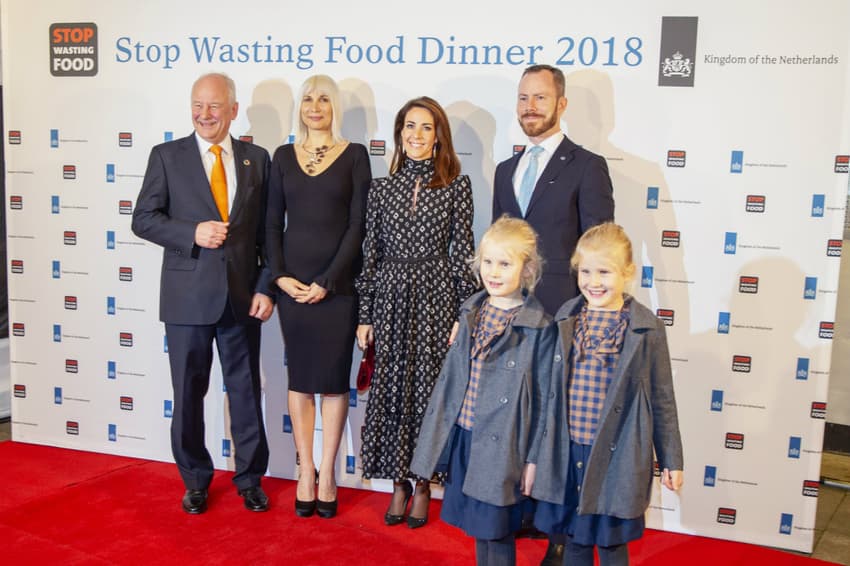Danish princess eats meal made from surplus in dinner against food waste

Denmark’s Princess Marie, Minister for the Environment and Food Jakob Ellemann-Jensen and ambassadors from several countries participated in a Copenhagen dinner to raise awareness of the issue of food waste.
During the International Stop Wasting Food Dinner, which is set to become an annual event, a menu was served made of surplus food, prepared by Lucas Jeffries of Dutch anti-food waste restaurant InStock, and Denmark’s Martin Jacobsen, chef at Copenhagen Michelin restaurant Kadeau.
The event was organised by the Dutch embassy in Copenhagen and Danish NGO Stop Wasting Food (Stop Spild Af Mad).
“The fight against food waste is one of the Netherlands’ top priorities. As the world’s second largest food exporting nation, we are assuming our responsibility to lead this fight,” Henk Swarttouw, the Netherlands’ ambassador to Denmark, said in a statement.
‘Ugly’ and imperfect fruits and vegetables and other good surplus food, which otherwise would have been wasted, were used to prepare the meal and guests were given the opportunity to take the leftovers home in biodegradable boxes, so nothing was wasted.
It is not known whether the Princess took home one of the boxes.
“We are very honoured and thankful that H.R.H. Princess Marie participated in our dinner against food waste - and I would also like to thank all of the guests,” Stop Wasting Food founder Selina Juul said.
“I am delighted to see that this important agenda has got such a strong anchoring,” Juul added.
One of the stated aims of the dinners was to inspire key actors present to embed the issue into their own organisations and projects, according to a joint press release issued by Stop Wasting Food and the Dutch and Swedish embassies in Copenhagen.
Other guests included representatives from Carlsberg, The Danish Agriculture & Food Council, Nestlé Nordics and HORESTA, the industry organisation for the Danish hospitality sector.
Juul’s organisation, which has for over a decade campaigned to reduce food waste in Denmark, is also involved with a government thinktank to develop the country's strategy on the issue.
Earlier this year, figures from the Danish Environmental Protection Agency showed that Danes living in apartments have reduced food waste by 24 percent per person and Danish households have reduced food waste by an average of eight percent per person over the past six years.
“We still have a lot of work ahead of us, especially focusing on detached households, but overall the new numbers show that we are moving in a good direction," Juul said when the figures were released.
Next year’s Stop Wasting Food Dinner in Copenhagen is scheduled to be hosted by the Embassy of Sweden.
READ ALSO: Danish producer saves 75 tonnes of 'ugly' tomatoes
Comments
See Also
During the International Stop Wasting Food Dinner, which is set to become an annual event, a menu was served made of surplus food, prepared by Lucas Jeffries of Dutch anti-food waste restaurant InStock, and Denmark’s Martin Jacobsen, chef at Copenhagen Michelin restaurant Kadeau.
The event was organised by the Dutch embassy in Copenhagen and Danish NGO Stop Wasting Food (Stop Spild Af Mad).
“The fight against food waste is one of the Netherlands’ top priorities. As the world’s second largest food exporting nation, we are assuming our responsibility to lead this fight,” Henk Swarttouw, the Netherlands’ ambassador to Denmark, said in a statement.
‘Ugly’ and imperfect fruits and vegetables and other good surplus food, which otherwise would have been wasted, were used to prepare the meal and guests were given the opportunity to take the leftovers home in biodegradable boxes, so nothing was wasted.
It is not known whether the Princess took home one of the boxes.
“We are very honoured and thankful that H.R.H. Princess Marie participated in our dinner against food waste - and I would also like to thank all of the guests,” Stop Wasting Food founder Selina Juul said.
“I am delighted to see that this important agenda has got such a strong anchoring,” Juul added.
One of the stated aims of the dinners was to inspire key actors present to embed the issue into their own organisations and projects, according to a joint press release issued by Stop Wasting Food and the Dutch and Swedish embassies in Copenhagen.
Other guests included representatives from Carlsberg, The Danish Agriculture & Food Council, Nestlé Nordics and HORESTA, the industry organisation for the Danish hospitality sector.
Juul’s organisation, which has for over a decade campaigned to reduce food waste in Denmark, is also involved with a government thinktank to develop the country's strategy on the issue.
Earlier this year, figures from the Danish Environmental Protection Agency showed that Danes living in apartments have reduced food waste by 24 percent per person and Danish households have reduced food waste by an average of eight percent per person over the past six years.
“We still have a lot of work ahead of us, especially focusing on detached households, but overall the new numbers show that we are moving in a good direction," Juul said when the figures were released.
Next year’s Stop Wasting Food Dinner in Copenhagen is scheduled to be hosted by the Embassy of Sweden.
READ ALSO: Danish producer saves 75 tonnes of 'ugly' tomatoes
Join the conversation in our comments section below. Share your own views and experience and if you have a question or suggestion for our journalists then email us at [email protected].
Please keep comments civil, constructive and on topic – and make sure to read our terms of use before getting involved.
Please log in here to leave a comment.